Introduction of Biochemical Treatment
Wastewater Biochemical Treatment System is to effectively remove the soluble and partially insoluble organics in wastewater by using the life activity process of microorganisms, so as to purify the water.
Gather all the innumerable microorganisms in a pool to create an environment (such as temperature, PH value, oxygen, nitrogen, phosphorus and other nutrients) that is very suitable for microbial reproduction and growth, so that microorganisms can proliferate in a large number to improve the speed and efficiency of their decomposition of organic matter. Then the wastewater is pumped into the tank, so that the organic substances in the wastewater can be oxidized and degraded during the life activities of microorganisms, so that the wastewater can be purified and treated.
How Do Microorganisms Decompose And Remove Organic Pollutants From Wastewater?
As there are carbohydrates, fats, proteins and other organics in the wastewater, these inanimate organics are the food of microorganisms. Some of them are degraded and synthesized into cellular substances (combined metabolites), and the other part is degraded and oxidized into water, carbon dioxide, etc. (catabolic products). During this process, the organic pollutants in the wastewater are degraded and removed by microorganisms.
What Factors Are Microorganisms Related To?
In addition to nutrition, microorganisms also need appropriate environmental factors, such as temperature, PH value, dissolved oxygen, osmotic pressure, etc. to survive. If the environmental conditions are abnormal, the life activities of microorganisms will be affected, and even mutation or death will occur.
What Is The Most Suitable Temperature Range For Microorganisms To Grow And Reproduce?
In wastewater biochemical treatment system, the most appropriate temperature range for microorganisms is generally 16-30 ℃, and the maximum temperature is 37-43 ℃. When the temperature is lower than 10 ℃, microorganisms will no longer grow.
Within the appropriate temperature range, the metabolic rate of microorganisms will be increased and the removal rate of COD will be increased by about 10% when the temperature is increased by 10 ℃; On the contrary, the removal rate of COD will decrease by 10% every time the temperature decreases by 10 ℃, so in winter, the biochemical removal rate of COD will be significantly lower than that in other seasons.
What Is The Most Suitable PH Range For Microorganisms?
The life activity and material metabolism of microorganisms are closely related to PH value.
The adaptation range of most microorganisms to PH is 4.5-9, and the most appropriate PH value is 6.5-7.5. When the PH is lower than 6.5, fungi begin to compete with bacteria. When the PH reaches 4.5, fungi will have a complete advantage in the biochemical tank, which will seriously affect the sludge settling results; When PH exceeds 9, the metabolic rate of microorganisms will be hindered.
Different microorganisms have different requirements for the adaptive range of PH value. In aerobic biological treatment, PH can vary between 6.5 and 8.5; In anaerobic biological treatment, microorganisms have strict requirements for PH, which should be between 6.7-7.4.
Wastewater biochemical treatment system is one of the most important processes in wastewater treatment system.
Compared with other treatment methods, biochemical method has the characteristics of low energy consumption, no dosing, good treatment effect and low treatment cost.
#QDEVU #WASTEWATERTREATMENT #SEWAGETREATMENT #WATERTREATMENT



